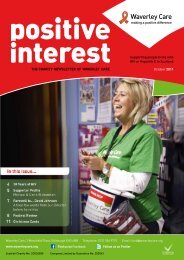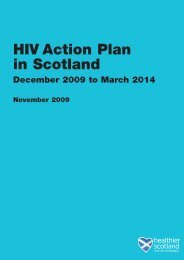I want to be like the others - Waverley Care
I want to be like the others - Waverley Care
I want to be like the others - Waverley Care
- No tags were found...
Create successful ePaper yourself
Turn your PDF publications into a flip-book with our unique Google optimized e-Paper software.
77I <strong>want</strong> <strong>to</strong> <strong>be</strong> <strong>like</strong> <strong>the</strong> o<strong>the</strong>rspractice in minimising vertical (mo<strong>the</strong>r <strong>to</strong> child) transmission of HIV. 4 More recently, ithas turned its attention <strong>to</strong> new areas, as well as maintaining its original interest inpregnancy and childbirth. Writing in 2002, Thorne et al highlight <strong>the</strong> increase innum<strong>be</strong>rs of perinatally infected children who now survive in<strong>to</strong> adulthood; althoughthis trend had <strong>be</strong>en seen <strong>be</strong>fore <strong>the</strong> widespread use of highly active antiretroviral<strong>the</strong>rapy (HAART), earlier and increasing use of HAART has allowed survival rates <strong>to</strong>improve fur<strong>the</strong>r (Thorne et al, 2002). ECS publications from 2003 onwardsdemonstrate extensive research in<strong>to</strong> <strong>the</strong> consequences of <strong>the</strong> use of HAART inpregnancy on infected and uninfected children, as well as examining a range of o<strong>the</strong>rissues, including possible gender, race and age differences, East-West differencesacross Europe, and <strong>the</strong> additional impact of co-infection (Hepatitis B or Hepatitis C)on pregnant women with HIV.Research evidence from <strong>the</strong> Collaborative HIV Paediatric Study and National Studyof HIV in Pregnancy and Childhood provide support for <strong>the</strong> epidemiological findingsof <strong>the</strong> ECS. Gibb et al (2003) identify reductions of 80% in mortality and 50% inprogression <strong>to</strong> AIDS amongst children perinatally infected with HIV in <strong>the</strong> UK andIreland <strong>be</strong>tween 1997 and 2002. The authors also note an 80% decrease in hospitaladmission rates, although <strong>the</strong>y go on <strong>to</strong> point out that <strong>the</strong> actual num<strong>be</strong>r ofadmissions decreased by only 25%, suggesting that <strong>the</strong> increasing num<strong>be</strong>r of HIVinfected children requiring care has implications for services in <strong>the</strong> UK and Ireland.Judd et al (2006) similarly report on 10 years of paediatric care for children infectedperinatally from 1996 <strong>to</strong> 2006. Judd et al state that <strong>the</strong> characteristics of this group ofchildren have changed in recent years. Many children now present with HIV at anolder age, and a large proportion are coming from abroad; this picture is also said <strong>to</strong><strong>be</strong> found in o<strong>the</strong>r European countries. The num<strong>be</strong>rs of children with new diagnosesand children receiving care continue <strong>to</strong> increase each year, and most new arrivalshave not previously received antiretroviral treatment. Looking ahead, Judd et alpredict that more children will <strong>be</strong> presenting who have <strong>be</strong>en taking simple, fixed-dosecombinations of generic drugs, and more children may have resistance <strong>to</strong> drugs.More encouragingly, <strong>the</strong>y note that initial decreases in overall rates of progression <strong>to</strong>AIDS and death after <strong>the</strong> introduction of HAART in 1997 have <strong>be</strong>en sustained, withfur<strong>the</strong>r decreases <strong>be</strong>tween 2002 and 2006. One of <strong>the</strong> repercussions of this is that4 His<strong>to</strong>rically, <strong>the</strong> vast majority of HIV infections in children were due <strong>to</strong> vertical (mo<strong>the</strong>r <strong>to</strong>child) transmission; children acquired HIV from <strong>the</strong>ir mo<strong>the</strong>rs during pregnancy, around <strong>the</strong>time of birth or through breast feeding.











